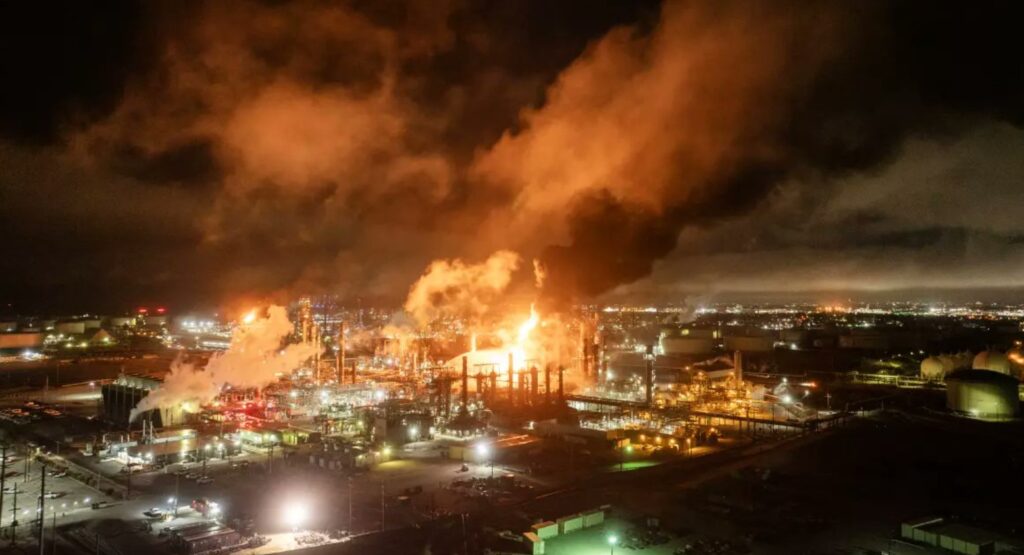The Chevron El Segundo Refinery, located just outside Los Angeles, experienced a significant fire on October 2, 2025, drawing widespread attention due to its role in supplying critical fuels to Southern California. As one of the state’s key energy facilities, any disruption here can ripple through regional fuel markets. This update covers the latest on the incident, including damage assessments, potential timelines for resumption, and the refinery’s production capacities for gasoline, diesel, and jet fuel.The Incident: What HappenedOn Thursday, October 2, at approximately 9:30 p.m., an explosion led to a massive fire at the refinery’s Isomax 7 unit, which is responsible for converting mid-distillate fuel oil into jet fuel.
Flames were visible for miles across the South Bay, prompting emergency responses from Chevron’s on-site fire brigade and local agencies, including teams from El Segundo and Manhattan Beach.
The blaze produced large plumes of smoke and was contained without spreading to nearby residential areas. Fortunately, all personnel and contractors were accounted for, with no injuries reported.
The fire was fully extinguished by the morning of October 3.
Chevron has initiated an internal investigation into the cause, which remains unclear as of October 4.
The company is coordinating with regulatory bodies, including CalOSHA, the California Energy Commission, and the South Coast Air Quality Management District, to monitor air quality and ensure safety.
Precautionary air monitoring in surrounding communities showed no immediate public health threats, and no evacuation orders were issued.
Is this a Possible Drone Strike?
The fire at the Chevron El Segundo refinery in California.
The most widely circulated theory today is that it was a strike by Venezuelan drones.
This suggests that Venezuelan cartels operating in the United States decided to get even for the US Navy sinking their boats full of… pic.twitter.com/e8cBTQpXm9
— Victor vicktop55 commentary (@vick55top) October 4, 2025
Damage Assessment
As of the latest reports, the full extent of the damage is still under evaluation.
The fire primarily affected the Isomax 7 unit, but led to the shutdown of several key processing units, including a 60,000 barrel-per-day (bpd) catalytic reformer, a 45,000 bpd hydrocracker, and a 73,000 bpd fluid catalytic cracker.
However, the refinery’s crude distillation units remain operational.
Overall, the refinery is considered down, with traders assessing the impacts on fuel supplies.
No detailed damage reports have been released yet, but the incident is part of a series of U.S. refinery fires in 2025, highlighting ongoing safety challenges in the industry.
Timeline to Bring Back Online
Chevron has not provided a specific timeline for resuming full operations, as assessments are ongoing.
Industry analysts speculate that downtime could range from a few days to weeks, depending on the damage.
For context, shorter outages (under 72 hours) might have minimal lasting effects, while prolonged shutdowns (over 10 days) could lead to significant supply disruptions.
Updates are expected as the investigation progresses, with Chevron committing to share more information with stakeholders.
Production Capacities: Gasoline, Diesel, and Jet Fuel
The El Segundo Refinery is California’s second-largest, with a rated crude oil processing capacity of 290,000 bpd, though it typically operates at around 280,000 bpd.
It plays a vital role in the region’s energy supply, accounting for about 17% of California’s total crude oil refining capacity.
Key production details include:Gasoline: Approximately 45% yield, equating to about 110,000 bpd. The refinery holds a 20% market share for gasoline in Southern California.
Jet Fuel and Diesel (Combined): Around 41% yield, totaling roughly 100,000 bpd. Notably, it supplies 40% of the jet fuel consumed at Southern California airports.
The facility’s output represents about one-sixth of Southern California’s gasoline supply, varying seasonally.
|
Product
|
Yield Percentage
|
Daily Output (bpd)
|
Regional Market Share
|
|---|---|---|---|
|
Gasoline
|
45%
|
~110,000
|
20% in SoCal
|
|
Jet Fuel & Diesel (Combined)
|
41%
|
~100,000
|
40% of SoCal Jet Fuel
|
Potential Impacts and Outlook
The shutdown has already disrupted jet fuel supplies to areas like Los Angeles International Airport, potentially leading to basis spikes if the outage extends.
On the gasoline front, California’s already high prices—averaging $4.64 per gallon as of October 3—could rise by 15 to 30 cents per gallon, depending on the damage extent.
Broader effects might include increased imports from Asia or the U.S. Gulf Coast to fill gaps, with freight costs and arbitrage opportunities in play for longer disruptions.
Past update on the overall California Energy National Security Crisis
Stu Turley and Michael Tanner covered the closure of the Valero refinery on this episode of the Energy News Beat podcast. The question remains if Chevron will want to reopen the refinery. As David Blackmon has said, this should be on the Trump Administration’s Radar to get moving and repairs financed quickly.
As this situation evolves, the Energy News Beat will continue monitoring developments. With energy markets sensitive to such events, swift recovery is crucial for maintaining supply stability in California. Stay tuned for further updates.
Have you calculated your Tax Burden in 2025?
Crude Oil, LNG, Jet Fuel price quote
ENB Top News
ENB
Energy Dashboard
ENB Podcast
ENB Substack

